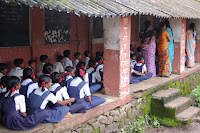Namaste from
Mumbai my little samosas!
I'm writing to you from my room at the YWCA International Guesthouse in "
Fort," a neighborhood with some lovely old buildings that I hope to get a better look at tomorrow. My room is no frills but spic and span. As I opened the door to a gleaming white bathroom, I channeled my mother with a faint but audible sigh of "oh thank God."
It just occurred to me that this is the perfect place to spend a few days before I meet up with the rest of my classmates for our course on social enterprise. For one, the
Mumbai chapter of the
YWCA (the Young Women's Christian Association) seems to have created an income generating arm in this guesthouse. I need to learn more, but I suspect that the guesthouse provides a sustainable funding stream for the YWCA to carry out its social programs for women and girls. Secondly, the first YWCA in England was created to house Florence Nightingale's army of nurses in transit to and from the Crimean War. As I've learned in reading for my class,
Florence was a tough bird and grandmama social entrepreneur who transformed the nursing industry. A very auspicious place to begin!
Other than general dampness from the monsoon rains and finding symbolism in my 20' x 10' room, my first day has been all about challenging my American notion that the customer is always right. So far, today's theme seems to be that the customer is probably wrong and/or doesn't quite know what she's talking about.
I landed at around 4 AM and after a long line for a prepaid taxi from the airport, made my way here by about 7. Check-in wasn't until 12:30 but I was told a room could be available by 11. I'd been hoping to skate in despite the later check-in (I've always thought of check-in times as general guidelines - the way drivers here think of traffic signals), but figured no bigs. While the thought of sweating it out in a room for four hours didn't sound heavenly, the lounge was equipped with chairs and I was equipped with something to put in them as well as a book to read. The "no" stung a bit, but you know, I get it. Maybe they were still making my bathroom sparkle like John Edwards' teeth. And after all, check-in time is check-in time. And then:
Cara: Is there a dining room?
Reception: Yes but it is for guests only. You may have your complimentary tea in the lounge. (**note dear reader, he had just handed me back my Visa card after charging me the Rs 6204 for my two night stay. )
Cara: Oh OK.
::whimper - shuffles back to lounge::
At home and with a circadian rhythm undisrupted by jetlag, I most definitely would have put up a fight. But my head hurt and the thought of additional talking made it hurt more.
Later that day...something like this...
Cara: Oh hello this is Cara Hayes- my internet password doesn't seem to be working.
:: we double check the numbers - still no dice::
Reception Person 2: OK please come down and get another number.
....
Cara: Hello I'm here for my new internet password.
Reception Person 2: You need to bring down your computer so I can check the password (Read: Hey dumbass, since you can't use your pointer fingers to hit numbers sequentially I'll have to do it for you).
....
Cara: Oh, OK. I'll just go back upstairs then. ::pause. whimper. shuffle back upstairs.::
For the record, he couldn't get the number to work either. Victory! (?)
Still later... goes a little somethin' like this...
Cara: Hello. I'd like a taxi to Leopold's please.
Reception 3: It's just a five minute walk around the corner. Just walk.
Cara: Oh, OK. ::pause. whimper. open umbrella. ponder fat drops of monsoon rain. shuffle out the door::
I was on my way to meet Krista, a friend from grad school who I was lucky to overlap with for one night here. After some fantastic conversation and paneer tikka masala at
Leopold Cafe, we decided to get some ice cream.
Cara: We'd like some ice cream please.
Waiter: In this weather? (editor's note - hot, sticky and tropical) No. Bad for your throat. Have some cake.
I think my first (three) diet coke(s) in 24 hours gave me my mojo back, for I did not whimper nor did I shuffle. I politely responded that we really did want some ice cream please.
Per my development theory all-time-fave Amartya Sen in The Argumentative Indian, I think I may have just spent my entire day witnessing the cultural bedrock of Indian democracy. I am honored.
Tomorrow, I will sightsee 'til my heart's content and I expect to experience the best of the city. In my head, I walk out the door and it will go something like this:
http://www.youtube.com/watch?v=Zy9eftbGs0U.



































